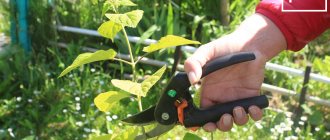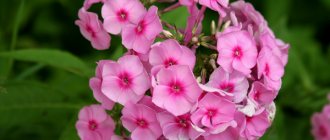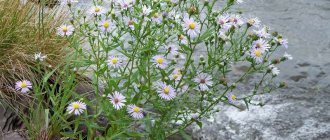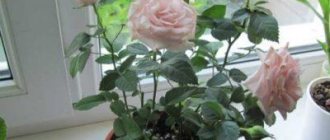In addition to tall roses, climbing varieties are widely used in landscape design, characterized by long and abundant flowering. Their use adds sophistication to any composition. For this reason, they are an indispensable element of the most daring design solutions. One such plant is the Swanee ground cover rose, or Swani as it is sometimes called. It has the ability to grow quickly and cover large areas of the bed, filling empty space.
Swanye cover roses do not require bushing.
History of selection
The ground cover rose Swany was bred in France in 1978. It was developed by Meilland. The founder of the Mayland nursery, Marie Louise, worked on the creation of this variety.
Two evergreen roses, Rosa sempervirens and Rosa wichurana, became the basis for the Swanee variety. The resulting variety was able to adopt only the best characteristics from its ancestors. This has made Swani one of the most popular ground cover varieties in cultivation.
Initially, the variety received the temporary name “MEIburena”, but at the first exhibition it was presented under its current name. Since then, Swany has become an innovative ground cover rose in its usefulness and decorative value, surpassing all other varieties known at that time.
The best varieties
Great popularity creates demand, so many new varieties of ground cover roses have appeared with unique characteristics.
Winter-hardy
Breeders have achieved incredible success in creating varieties that can withstand the complex effects of the environment in winter and early spring. Varieties considered winter-hardy:
- The Fairy. This variety can be considered the standard in terms of winter hardiness and the most unpretentious to grow. The bush is spreading, up to 70 cm high. The width of shoot growth is 1.2 m. The leaves are small, shiny, bright green. The growth rate of shoots is average. The flowers are pale pink, but under the sun they can fade to almost white. Bunch-shaped racemes contain from 10 to 20 rosette-shaped buds. Flower size is 3 – 5 cm. The variety grows well in partial shade. Withstands frosts from -20 to -23°C without shelter;
The Fairy variety, although it blooms a little later than the others - in July, but pleases the eye until October
Due to the height of the bush, the Fiona variety can easily be a soloist in a flower arrangement.
Due to the abundant flowering of the Hello variety, leaves are sometimes not visible
Disease resistant
The following varieties are considered the most resistant to common rose diseases:
- Ballerina. This variety has a long flowering period and a large number of flowers with a wonderful aroma. The plant is a large drooping plant - the height of the bush is from 90 cm to 120 cm, sometimes up to 150 cm. Width - 175 cm. The branching is strong. The flowers are simple, collected in racemes of 5 - 10 pieces. The flower size is 2–3 cm. The newly opened bud is dark pink, but then the petals lighten and become white with pink edging around the edges. The variety is highly resistant to powdery mildew and black spot;
The Ballerina variety, although it has simple flowers, looks very delicate
The Appleblossom Flover Carpet variety pleases with lush flowering
The Bassino variety, incredibly popular all over the world, is called Suffolk in the UK.
Most beautiful
Varieties considered one of the most beautiful:
Amber Cover. Plant height - 80 - 100 cm, width - 90 - 150 cm. The bush is dense, grows evenly in width. A special feature of the variety is the small number of thorns. Double flowers are quite large, up to 10 cm in diameter. Against the background of dark green foliage, the yellow spherical flowers look amazingly bright. Fading flowers become lemon-colored. During flowering, roses emit a pleasant rosehip aroma;
The Amber Cover rose has attractive cup-shaped inflorescences that appear continuously throughout the growing season.
The unusual color scheme of the Jazz rose allowed it to win many awards at prestigious exhibitions
Based on the Swany variety, many varieties have been created that have the same name
When choosing a ground cover rose variety for your garden, pay attention not only to the beauty of the flowers, but also to the plant’s ability to withstand the vagaries of nature and disease
Description and characteristics of the ground cover rose Svani
This rose is considered one of the most popular ground cover roses, and this is no coincidence. It looks attractive throughout the season and is easy to care for.
Ground cover rose Svani is a lush shrub with numerous creeping stems. It reaches a height of 50-60 cm and a diameter of 1.50-2.0 m, depending on growing conditions. The shrub has long, thin stems that bend well, but cannot be broken. They have dense foliage. The bark on young shoots is light green, but becomes dull brownish-gray with age. The branches are covered with small, round, hook-shaped spines.
Important: the ground cover rose Svani is fast-growing, so the plant grows to a full-fledged bush in the second year after planting.
Young leaves are light green; later they become darker and glossier. This significantly increases the decorative value of the shrub. The leaves alternate. They consist of 5-7 oblong-oval lobes, which are attached to a common petiole. Each segment does not exceed 2.0-2.5 cm in length and barely reaches 1.5 cm in width. The surface is smooth on both sides.
Rose Svani blooms continuously throughout the season. This is achieved through the constant growth of new shoots, at the top of which buds form. It begins in late May or early June, depending on the growing region. The flowers of this ground cover rose are quite large for their species. When fully opened, they reach 5-6 cm in diameter.
The shrub produces numerous, round, pointed buds, which are collected in umbrella-shaped inflorescences on long stems. Each umbel consists of 5-14 flowers, and the number of flowers on mature bushes can reach 20. The flowers consist of graceful, slightly curved petals. They are pure white, but may have a soft pink color in the center of the flower.
The rose has dense, 40-50 petals and a pleasant aroma.
The aroma is pleasant, floral, but weak. It increases slightly only in the late evening and at night.
Important: Rose Swaney is suitable for cutting, its flowers remain fresh for 3-5 days in a vase.
The root system is mainly concentrated in the upper layers of the soil. It branches and goes horizontally into the soil.
The white groundcover rose Swanee is moderately frost-hardy. This shrub tolerates temperatures dropping from -12 to -20 degrees. Since most of the plant's flowers are formed on last year's shoots, it must be covered for the winter. This is not difficult to do, since the ground cover rose forms a low bush.
Under favorable conditions, it is practically resistant to fungal diseases. However, in case of prolonged rains and cool weather, the plant's resistance will be reduced. To avoid this, preventive spraying of bushes with fungicides should be carried out.
Usage
Svani roses grow well in flower beds and artificial flowerpots
Rose "Swani" quickly turns into a lush, spreading bush that can gracefully hang over a slope, so sloping areas are considered the ideal place for planting this variety. “Swani” is actively used to decorate borders and paths. The variety looks great both in simple flower beds and in complex mixborders; it grows well in containers and containers that can be placed throughout the garden plot. Ground cover roses will grow well in artful flowerpots or flower beds located on a hill. Delicate thin stems will gracefully hang from planting containers, decorating the garden area with lush flowers.
Growing in various containers also has practical benefits: it is easier to fertilize the soil in confined spaces and it is easier to arrange a good drainage system, and these two conditions will contribute to more luxuriant flowering of roses.
The snow-white flowers of the “Swani” rose look especially chic in white gardens. An excellent background for them can be dark green shrubs that will set off the lush white blooms of roses. Honeysuckle, viburnum, lilac and brilliant cotoneaster are suitable as such a background.
Rose “Swani” goes well with other flowers
You should not neglect coniferous shrubs, which will fit perfectly into the garden where “Svani” roses grow. Cossack juniper and mountain pine are suitable as neighbors for roses, which will dilute and highlight the snow-white caps of rose bushes. Orange daylilies and sky-blue delphiniums will look great next to roses.
The ground cover rose "Swani" has some qualities of climbing varieties, so you can try decorating gazebos, pergolas, fences and hedges with white buds.
In addition to purely decorative decoration, roses can also bring practical benefits: if they are planted on a slope with deteriorating soil, they will compact the top layer and protect it from erosion during precipitation.
ATTENTION! It is not recommended to plant “Swani” roses next to buildings and trees, otherwise the flowers will hurt.
Advantages and disadvantages of the variety
According to the description, photographs presented and the opinions of gardeners, the ground cover rose Svani is characterized by high decorativeness and low maintenance requirements, which distinguishes it from other varieties. However, like other varieties, it has both advantages and disadvantages. Therefore, when choosing, you should pay attention to them, so that later it does not become an unpleasant surprise.
The flowers of the undergrowth are rosette-shaped.
The main advantages are:
- Long, abundant flowering;
- Versatility of use in landscape design;
- Easy care;
- Good frost resistance;
- Resistance to fungal diseases;
- High decorative value;
- large flower diameter;
- suitable for cutting;
- easy to reproduce;
- recovers quickly in case of frost.
Flaws:
- The shrub does not have the ability to self-clean;
- weak floral aroma;
- Roses become less decorative if it rains for too long;
- Requires shelter for the winter.
Features of creeping roses
If the ancestors of ground cover roses bloomed only once and bore fruit abundantly in the fall, then modern varieties are distinguished by lush and abundant flowering, lasting throughout the summer season, until frost. In addition, all plants classified in this group have a number of biological and decorative characteristics that unite them:
- high shoot growth rate;
- strong branching of bushes, the width of which in most cases exceeds the height;
- abundance and duration of flowering;
- high decorativeness of not only flowers, but also shoots, leaves, fruits;
- resistance to adverse environmental influences, as well as various diseases and insect pests;
- ease of care and pruning.
Varieties of Svani roses
The enormous popularity of the ground cover rose Svani inspired its creator to create other varieties based on it. They all have common characteristics, but there are also clear differences. So make sure you are familiar with the popular subspecies of Swana to avoid any confusion.
Important: Swana Mimini cover roses are not self-cleaning plants, so the bushes must be pruned regularly to prevent the flowers from wilting, which reduces the aesthetics of the plant.
Swany Mimi
Introduced in 2001, it was technically named MEIshasen. Swany Mimi is characterized by medium growth and its stems are almost thornless. Its buds will be pink at first, but as they open, the outer petals become light, and only the center remains light. This gives it a very delicate and elegant look. Roses are no more than 3 cm in diameter. But the bush produces a huge number of them, so when they bloom, the leaves are almost invisible.
In many catalogs, the rose Mimi Swany is listed as Mimi Eden.
Super Swany
Introduced in 1987. Super Swani forms spreading bushes, rarely reaching 1.4 m in height. Its flowers are densely double, almost white, but may have a slight pinkish tint along the edges of the petals. Their diameter is about 5-6 cm.
Rose Super Swany is odorless.
Pink Swany
This ground cover rose was introduced in 2003 and is specifically designed for planting in groups. Pink Swany has dense, open flowers in which even when fully opened the center of the flower is not visible. The bushes reach a height of 60-80 cm and a diameter of about 110 cm. But since each flower has 90-100 petals, it looks much larger than its size. The flowers are a shade of pink with a slight hint of purple. They reach 7-8 cm in diameter.
The pinkish hue of the Peak Swany cover rose is vibrant in the spring and fades in the fall.
Rose Red Swany
A cover rose with a spreading head up to 2.0 m in diameter and about 60 cm in height. Red Swany rose has bright red flowers with a delicate aroma. It is also characterized by delicate petals. The flowering period is long, beginning in early summer and continuing until autumn frosts.
The Red Swanee cover rose does not require pruning.
Description of appearance
But let's finally take care of our Svani! The fact that it belongs to the group of ground cover roses has already been said. The bush is branched, with a maximum height of half a meter, but usually significantly lower. The shoots are thin and long, growing almost parallel to the ground and easily lying on its surface. The leaves are juicy green, slightly shiny, and smaller than average in size.
On each stem an inflorescence of about ten small, about 4-5 cm in diameter, white flowers is formed. There is a slight pink tint in the center of the flower. The aroma is barely audible, but it is always present. The first buds appear early, sometimes already at the end of spring, and continue to bloom almost until frost. There may be a short break in summer, especially in dry weather.
Reproduction methods
This variety is easily propagated by pruning and cuttings. The first of them is simple and can be used even by an inexperienced gardener. It is enough to bury several shoots 5-10 cm deeper into the soil, leaving only the tops, and keep the soil slightly moist throughout the season. Next year you can separate the shoots from the mother bush.
The cutting method is more complicated, but allows you to get a large number of cuttings. To do this, before flowering, cut the shoots into pieces 10 cm long with 2-3 internodes. Remove the lower leaves completely and leave the upper ones to release the juice. Then dust the cuttings with any rooting agent and plant them in the soil. Cover them with transparent lids to create optimal conditions. Young seedlings can be transplanted to a permanent place only at the age of 2 years.
Plant care
In order for the Swanee rose, as it is sometimes called, to grow and develop normally, it requires complete and high-quality care.
Watering rules and humidity
It is necessary to water the plant in the morning or evening. Otherwise, burns may appear on the foliage.
In the first year, the rose is moistened twice a week. Then this can be done once every 7-10 days. Irrigation schedules are affected by weather conditions.
Fertilizing and soil quality
During the growing season, the crop needs to be fed three times a season. The first 2 times, complex mineral preparations are used. The last feeding involves the use of phosphorus and potassium.
Pruning and replanting
It is recommended to prune the crop in spring. During this period, it is worth removing frost-damaged branches and dry shoots. In the fall, it is necessary to carry out sanitary pruning of the crop. In this case, you need to get rid of weakened and diseased shoots. Once every 5 years it is worth performing bush rejuvenation.
Important! Be sure to remove wilted buds in a timely manner. This helps stimulate re-blooming, and in this way it is possible to avoid the loss of the decorative properties of the crop.
It is not recommended to replant an adult plant. If such a need arises, the procedure is carried out by transshipment.
Growing and care
Cover rose Svani can be planted in open ground in spring in the central and northern regions and in autumn in the southern regions. Plant in sunny, slightly shaded areas with fertile soil and good aeration.
Do not plant this variety in the shade, otherwise it will not bloom profusely.
2 weeks before planting, prepare a planting hole measuring 50 x 50 cm. A 7-10 cm layer of drainage is placed at the bottom, and an equal volume of soil mixture of turf, sand, mulch and peat is poured on top. When planting, the root collar of the seedling should be buried 2 cm.
Important: When planting Svani ground cover roses, the groundwater level must be at least 80 cm below the groundwater level.
Standard care instructions must be followed when growing this variety. These include timely watering in the absence of seasonal precipitation. Use water with a temperature of +18-+20 °C. Watering should be done in the evening to avoid burning the leaves.
Cover rose Svani also needs nutrients. Therefore, in the spring, at the beginning of cultivation, apply nitroammophoska fertilizer (30 g per 10 l) or fermented chicken manure (1:15). Then add mineral mixtures of phosphorus and potassium, which will increase the number of buds, prolong flowering and increase the frost resistance of the bush. The frequency of their use is once a month.
To prevent the growth of weeds under the shoots of the Swaney rose, cover the shoots with a 3 cm layer of tree bark. This mulch not only reduces watering, but also prevents overheating of the roots in hot weather and ensures an acidity level of about 6.0-6.5 pH.
The ground cover rose Svani does not need to be formed. Therefore, every spring it is only necessary to remove damaged and frozen shoots, which reduces its decorative value. The bush must be covered for the winter. To do this, first cover the root system with a thick layer of soil and compact it. The entire rose should then be completely protected by a layer of non-woven material.
Important: In early spring, without waiting for intense heat, remove the cover from the Swanee cover rose, otherwise it will wither at the base.
Growing a flower, how to plant it correctly in open ground
Rose Blush - description and characteristics of the variety
To achieve success in growing a crop, you need to study its description and carry out planting work correctly.
This crop is not propagated by seed. It is best to use ready-made seedlings for planting. In mild climates it is permissible to use cuttings.
In regions with mild winters, the crop can be planted in the fall - from mid-September to mid-October. Thanks to this, roses will be able to adapt to new conditions before the onset of cold weather. If severe frosts are expected, planting work should be carried out in the spring.
Selecting a location
For culture, it is recommended to choose a well-lit area. Sometimes a shadow may appear. Roses should be placed in the west or southeast.
Loam is considered the ideal option for the crop.
Rose needs a lighted area
The soil should be neutral or slightly acidic. High-quality drainage and aeration are of great importance.
How to prepare the soil and flower for planting
One year before planting, it is worth adding nitrogen or organic fertilizers to the soil. If the soil is clayey or swampy, sand should be poured into the bottom of the depression.
Light sandy soil requires the use of a 10 cm layer of clay. To facilitate the rooting process, the soil in the recess must be thoroughly loosened.
Important! To prepare the seedling, it is recommended to trim the branches. There should be 3-5 buds on each of them.
Before planting, you should carefully examine the condition of the root system to identify damaged areas. They must be removed and the sections sprinkled with crushed coal.
Step by step landing procedure
To plant a crop, you must do the following:
- Spread the roots of the seedling. Buds below the grafting zone must be removed.
- Trim the roots and lower them into the clay solution.
- Place a 10 cm thick layer of sand at the bottom of the depression. This option is suitable for clay soil. For soil that is too loose, it is better to use clay.
- Fill 2 buckets of compost and make a small mound.
- Place the seedling in the hole. The grafting area should be located just below the surface of the ground.
- Lightly compact the soil.
- Water and cover with humus or compost.
Pests and diseases
This variety demonstrates resistance to diseases and pests. However, if the growing conditions are unsuitable and the plant is not properly cared for, the resistance of the Swanee rose is reduced.
Possible problems:
- Powdery mildew. The disease manifests itself as a white coating on the leaves, which then becomes a dirty gray color. This interferes with photosynthesis and causes leaves to wilt. Topaz should be used as a treatment.
- Black spot. The disease develops with sudden changes in day and night temperatures. Initially, black spots appear on the leaves, which then turn into spots. Eventually, premature defoliation occurs and the shoots become completely bare. Skor should be used as a preventive and therapeutic agent.
- Aphid. A small pest that develops on young leaves and shoot tips. It feeds on rose juice. If the infection is severe, the flower buds become deformed and the bush stops blooming. Contact Confidor Ekstra.
- Spider mite. A microscopic pest that cannot be seen with the naked eye. It can be recognized by dull leaf color, slow growth, misshapen buds, and tiny webs on the tops of branches. Actellik should be used.
Step-by-step care instructions
- Choosing a landing site.
Rose Lovely Green: a greenish-cream beauty in your gardenThe climbing rose Sympathy likes to grow in a well-lit and sunny area. It is best to plant the plant on the south side of the site.
- What should the soil be like?
Roses are grown on breathable loams. The soil must have slightly acidic properties. There must be a sufficient amount of minerals in the soil. - Landing.
Landing activities are carried out as follows:- Place drainage at the bottom of the planting hole using gravel or sand.
5 hours before planting, place the seedling in a container of water.
- Shorten shoots to 20 cm, remove weak ones, leave only medium and strong ones.
- Add 5 liters of water to each planting hole, and when it is absorbed, plant the plant.
- Carefully straighten its roots and sprinkle with soil, filling all the voids.
- Maintain a distance of 45-50 cm between bushes.
- Temperature.
In summer, the optimal temperature for a rose is 22-24 degrees, so you need to choose a place for it where there is no scorching sun rays during the day. In autumn, the flower can withstand temperatures of -5 degrees, and then the plant needs to be covered. - Watering.
Moisten the rose with settled water 1-2 times every 2 weeks. You need to pour 20-30 liters of water under each bush. It is better to carry out this procedure in the morning. After watering, lay a layer of mulch. For these purposes, manure composted with soil is used. Place rotted manure around the perimeter of the bushes, 2-3 cm away from the stems. After this, loosen the soil to a depth of 1-2 cm. - Feeding.
For the first 2 years after planting the plant, you do not need to add food to the soil. For 3-1 years, you can add nitroammophoska or manure. During the entire growing season, fertilize 2-3 times. For feeding on leaves and stems, the solution is diluted less than when watering. Next, using a broom soaked in the solution, spray the composition over the foliage and stems. Before such a procedure, the plant should be watered thoroughly. - Trimming.
In spring, broken and weakened branches are pruned. As soon as autumn comes, the already faded branches must be removed. This will stimulate the growth of new shoots, which will rejuvenate the bush.Young shoots need to be formed in the first and second years after planting. To do this, leave 5-7 skeletal weaves, and cut off the rest. In 4-5 years, the old skeletal branches will have to be replaced with younger ones. Thus, at 4-5 years old you need to choose the strongest lashes, leave them, and cut off the old ones. It is necessary to replace 1 old whip per year.
- How to tie up a plant.
Procedure:- Install the support immediately after planting the seedlings so as not to damage the overgrown root system.
Direct the stems horizontally on the grid, then the bud formation process will be active.
- You can secure the rose's lashes with thin wire.
- Transplantation. Transplantation of a climbing rose must be carried out in the spring, as soon as the ground thaws from winter frosts, and the buds on the branches have not yet woken up.
Procedure:- Carefully remove the above-ground part of the plant from the support, and dig up the bush, moving from its base with an indentation of 50-60 cm.
Remove the plant from the soil and remove excess soil from the roots.
- Place the bush in the already prepared planting hole, straighten the roots and point them down.
- The free space in the hole must be filled with soil mixture, lightly compacted and watered well.
- After 3-4 days you need to add more soil and spud up the bush.
- Preparing for winter.
In August, it is necessary to perform the last watering, loosen the soil and apply fertilizing. You need to cover the bushes after the air temperature drops to -5 degrees. The plant must be removed from its supports, and diseased and broken branches must be trimmed. After this, the whips are tied with a rope and pressed to the ground with metal or wooden hooks. Finally, fallen leaves or spruce branches are placed on the lashes.
Application in landscape design
Swani ground cover rose is widely used in landscape design. Its drooping stems can camouflage any unsightly surfaces. Therefore, it is often planted on slopes and near high borders. It is also ideal for alpine beds, front beds and for landscaping the entrance to pergolas.
Svani Stem Rose is also available for commercial use as its flowering stems look very elegant when raised, giving the appearance of a floral fountain.
It can also be grown as a planter to decorate balconies, terraces and stairs.
The most popular varieties
Hello
Hello
Low (about 50 cm), spreading bush. They are distinguished by large, densely double flowers, which during flowering change color from dark red to rich cherry. The flowers are odorless, but with the richest doubleness among ground cover roses. The variety is frost-resistant, immune, blooms profusely.
Swany
Swany
The bushes are tall, 75-80 cm. The crown is spreading, up to 2 m in diameter. The Svani rose stands out for its evergreen small shiny foliage and large umbrella inflorescences. Each contains up to 20 double, white with a pink center, fragrant flowers. Winter-hardy and very decorative shrub.
Ahtiar
Standard rose Ahtiar
A tall bush with long (1.2-1.5 m) flowing arched shoots. Large double flowers are collected in inflorescences. This landscape rose is used to create borders and green hedges, and is grown in a standard culture.
Ballerina
Ballerina
Tall, up to 2 m, bush with a rounded dense crown. Winter-hardy, drought- and disease-resistant. It blooms for a long time, continuously, until the onset of frost. Simple flowers are collected in brushes. The petals are white in the center, turning pink towards the edges. During flowering, the flowers increase in size and become somewhat lighter. They have a delicate musky aroma.
Scarlet
Scarlet
One of the most hardy and adaptive varieties. The bushes are low, up to half a meter. The foliage is dark and glossy. The flowers are double, deep red. Blooms profusely all summer and autumn
Fairy
Fairy
The seedlings quickly take root, the shoots grow actively and in a short time form dense thickets up to 60 cm high. White, sometimes with a pink tint, double flowers are collected in clusters of 30-40 pieces. They bloom from July until frost.
Amber Sun
Amber Sun
Spreading branched bushes, 50-60 cm in height and width. The branches are drooping. Small semi-double fragrant flowers of all shades of yellow - from copper at the beginning of flowering to cream at the end. Valued for long flowering, cheerful decorativeness, resistance to frost and rose diseases.
Matador
Matador
Low (up to half a meter) compact bushes. Scarlet semi-double flowers are grouped in racemes. One of the earliest flowering varieties, extremely resistant to diseases and tolerant of environmental conditions. Often planted in hanging pots and containers.
Fiona
Fiona
A strong bush up to 85 cm, with long arched branches. The fragrant flowers are double, bright pink, medium-sized, collected in inflorescences. Blooms profusely from early June until frost. Winter-hardy immune variety.
Agricultural technology
We have already written in detail about planting, pruning, care, and tying climbing roses to supports. We will repeat only the main points, and will focus on the peculiarities of cultivating the “Don Juan” variety.
Placement and boarding
The rose will grow most comfortably in a sunny place protected from the wind. But it grows well in partial shade without losing its decorative qualities. In fact, the sun that it can receive in the first half of the day is quite enough for this variety - you can place it so that in the afternoon it is deprived of direct sunlight.
The best time to plant roses is spring and autumn. Moreover, in regions with a cool climate and harsh winters, it is best to plant them in April-May, so that the plant can take root during the warm season, and in the southern regions - in the fall.
If you are planting the “Don Juan” variety near the wall of a house, dig a planting hole no closer than 40 cm from the support. It should be 60 cm in diameter and 30 cm deep. Pour a little planting mixture into the bottom of the hole and place the seedling in it so that its roots are directed in the opposite direction from the wall. Sprinkle them with the prepared substrate, tamp them down carefully, add soil and water generously. For this you will need at least 15 liters of water. Hill up the rose, no matter what time of year you plant it.
If your soil is poor, add a bucket of well-rotted compost or humus.
If you are planting several climbing roses, the distance between the bushes should be at least 3 meters.
Seasonal care
In the first months after planting, especially if it was done in the spring, the rose must be watered abundantly, spending at least 15 liters of water per bush. In the future, water the plant as the soil dries, since climbing varieties require more frequent watering than other varieties. Watering should be plentiful.
Feed this variety of rose regularly - it grows quickly and blooms profusely throughout the season, therefore, it requires increased nutrition. Foliar feeding gives very good results. The rose also needs loosening of the tree trunk circle, especially if you have not mulched it.
Formation of a bush
Rose “Don Juan” can be formed on a trellis - against the wall of the house, on a pergola, trellis or trellis, placing the main branches horizontally or in a fan and tying them with strong twine or thick wire in a plastic braid.
A plant formed around a pole, on an arch or next to a large tree will look very good. In this case, the main shoots are directed vertically and tied to a support.
Rose "Don Juan" has powerful thick stems. It can not be tied to a support, but formed in the form of a tapeworm (single focal plant) or a hedge (in this case, the distance between the bushes when planting is reduced to 2 meters).
Trimming
From a young rose, cut out only weak and immature shoots. If you grow the Don Juan rose on a trellis, then every spring, immediately after removing the winter shelter, cut out all frozen and weak shoots, shorten the main and skeletal branches by a third. All young branches from last year that are not needed for the further formation of the bush, cut by a third or remove completely - the “Don Juan” rose blooms on the young growth of this year.
When growing a plant without support, only sanitary pruning and trimming of excessively long vines will be mandatory if they suddenly go “in the wrong direction.”
Shelter for the winter
The “Don Juan” variety has high frost resistance, but this does not mean that it is able to winter without shelter and does not freeze. The more severe your climate, the more severe the shelter.
With the onset of the first frost, the rose is removed from its support, all weak or immature shoots are cut out, spud up and laid on spruce branches, covering the lashes on top with it. If a harsh winter is expected, the spruce branches are covered with agrofibre or spunbond.
It is very important to remove it on time - the roses are more likely to be destroyed by damping off than by freezing. We offer you to watch a video dedicated to growing and caring for the climbing rose “Don Juan”
There you will also hear reviews from flower growers about its winter hardiness and decorative properties:
We offer you to watch a video dedicated to growing and caring for the climbing rose “Don Juan”. There you will also hear reviews from flower growers about its winter hardiness and decorative properties:
How and where to buy Japanese roses
The species of these roses is not yet well known and widespread in some European regions, so there is little information about them. If you need to buy Japanese roses
, it is better to contact large exclusive representatives of Japanese nurseries with a license. Greenhouse workers will show you flowering specimens and give advice on care.
In ancient Greece, roses were used to improve beauty and maintain youth. The first rose water was made by the Persians in the 8th century, and the secrets of distilling rose oil were later learned. Rose petal oil is a rich source of unsaturated fats that nourish the skin and maintain optimal hydration. Among other things, Japanese rose helps brighten the complexion, discoloring age spots and freckles.
Insulation for the winter
The frost resistance of the rose is quite high, but in severe frosts the plant may die, so it is covered.
The bush is hidden only when stable frosts set in. Otherwise, on warm days it will warm up, and then in the cold it will freeze.
To prepare for wintering, remove all dried flowers and leaves from the bush, remove the branches from the base, and place them on a prepared spruce cushion. The branches are also covered with spruce branches on top, and then with non-woven material. Mix dry soil and manure and sprinkle the bush at the base with this mixture.
In spring, the protection is not removed immediately, but gradually. With the arrival of the thaw, remove the fabric covering, leaving the spruce branches - this will preserve the rose during return frosts. With the onset of warm weather, the spruce branches are removed.
The base of the bush is freed from soil, which is used as mulch, evenly distributing it over the surface of the soil around the rose, the stems are raised, and fixed to a support.
Varieties with abundant flowering
"Aspirin Rose"
The description of this variety of roses can begin with the fact that the bush is low-growing, but it is suitable for both landscape design and private gardens. The inflorescences begin to open in early spring and are completely unaffected by light frost. The color starts out bright pink, then fades to a brilliant white. Each brush contains up to 15 flowers; the bush is almost completely covered with them at the peak of flowering. These are always very bushy roses with a lot of foliage.
As for care, the rose is completely picky and has good resistance to damage by pests or fungi.
The plant blooms until late autumn, which is important for most gardeners.
"Super Dorothy"
This flower has good resistance to powdery mildew. The flower is formed in a dark pink color, with a small spot of less intense color in the center. If the bush grows in a place well lit by the sun, then its flowers become less colorful. There are no thorns on the shoots, and if they appear, they are very rare. The bush has a spreading shape, so it is ideal for a weeping trunk. The rose blooms late compared to other varieties, but it blooms until the first frost.
"Excelsa"
On the bush of this rose, small crimson buds are formed, which are collected into large inflorescences. You can plant such a plant near the weaving on an old tree to hide it or ennoble it. Small hedges are made from it. The maximum height of the branches is 4 meters; there are always many flowers on the side shoots, so you can form a climbing trunk with them. The flowers do not fall off, but fade on the bush, simply losing intensity and drying out gradually. This rose has a scent, but it is very weak.
"New Dawn"
This variety is distinguished by its gray-green foliage and silvery-pink flowers. The bush will bloom all summer regardless of whether it grows in fertile soil or is planted in poor and shaded soil. Recently, this rose has gained particular popularity among gardeners, since it can be used not only as a climbing rose. If you create the necessary support, the plant will rise to a height of five meters. When many flowers are formed, the branches may fall under their weight, so you need to tie them up sometimes. The flowers are double and delight with their beauty for several months. An incredible aroma emanates from the bush.
"Fairy"
This rose is on the list of those that are most common in the world. Over time, pink buds become very pale, sometimes even close in color to white. The brightness of the shade is best maintained as long as it is not hot outside. Airy large brushes are formed from 40 flowers. These roses bloom late, but in the fall they delight with their palette. With age, the bush becomes larger and larger; it can be taken from cuttings, since it is the easiest way to plant a plant in this way due to its ability to adapt to different conditions. The rose is less resistant to diseases, so it will be necessary to prevent them.
- https://7ogorod.ru/cvety/roza-svani.html
- https://golosros.ru/tsvety/luchshie-sorta-pochvopokrovnyh-roz-dlya-sozdaniya-yarkogo-kovra-v-sadu
- https://cveti-rasteniya.ru/roza-svani-pochvopokrovnaya.html
- https://vseolady.ru/roza-svani.html
- https://sortoved.ru/roza/roza-svani-swany.html
- https://ocvetah.life/otkrytyj-grunt/mnogoletniki/rozy-mnogoletniki/roza-suomi.html
- https://stroy-podskazka.ru/rozy/sorta/pochvopokrovnyh/
What are Canadian roses
Most varieties of so-called Canadian roses have undergone special testing for survival at temperatures from –30 to –40°C and really do not require special winter shelter - they do not need either spruce branches or spunbond.
In zones 3 and 4, only hilling is needed (it is best to sprinkle with garden soil at the rate of 1 bucket per bush measuring 1x1 m) and snow. Shoots usually freeze out along the snow line, and only if the winter temperature drops below 35 °C. At the same time, Canadian roses recover very quickly. This is a distinctive feature of all frost-resistant roses, inherent in the genotype of plants. When choosing a suitable variety, be guided not only by a beautiful photograph, but carefully read the description, look at the opinions of experienced collectors who have actually (!) worked with a particular Canadian, and do not know about it by hearsay.
The pedigree of Canadian roses allows us to divide them into three groups. Depending on the parents, the variety may be less winter-hardy; pay attention to this - some Canadians have winter hardiness zone 5.
Main advantages
This type of rose is quite common among amateur gardeners. The rose has both positive and negative reviews. As for the advantages, they are as follows:
- It grows as a bush and can expand, which is especially beneficial when creating a landscape design or decorating an area.
- The rose bush blooms almost all the time, from spring to the first frost.
- The white ground cover rose is ideal for decorating flower beds and alleys.
- Its aroma is gentle and pleasant, so early in the morning, leaving the house, you can enjoy it.
- The shrub does not require scrupulous care; it is enough to water and prune it on time, and nature does the rest.











